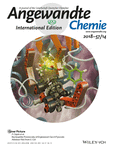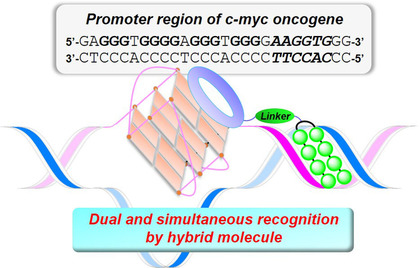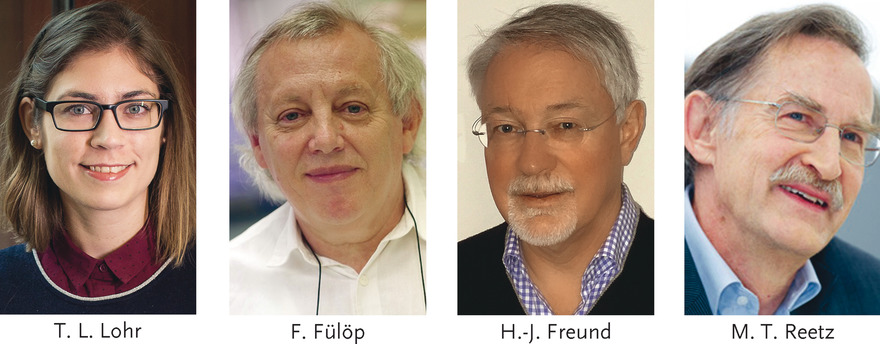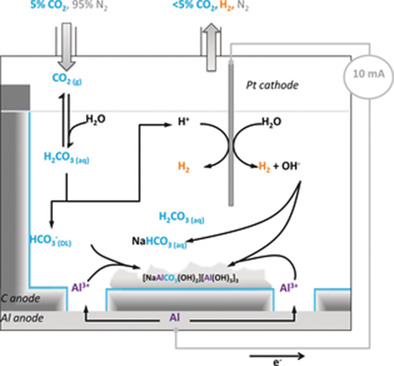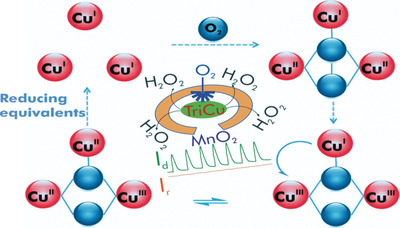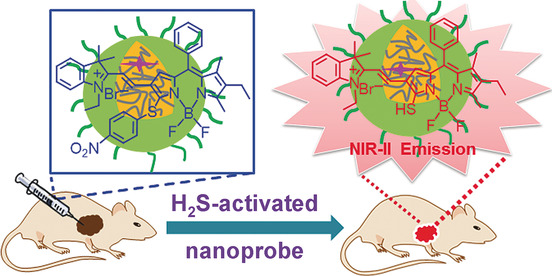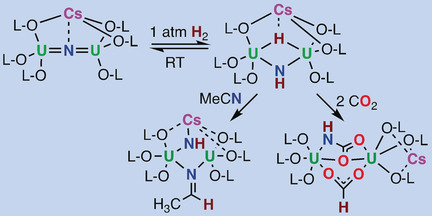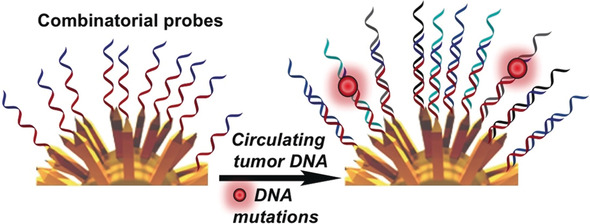Journal list menu
Export Citations
Download PDFs
Cover Pictures
Cover Picture: Nucleophile Promiscuity of Engineered Class II Pyruvate Aldolase YfaU from E. Coli (Angew. Chem. Int. Ed. 14/2018)
- Page: 3521
- First Published: 02 March 2018
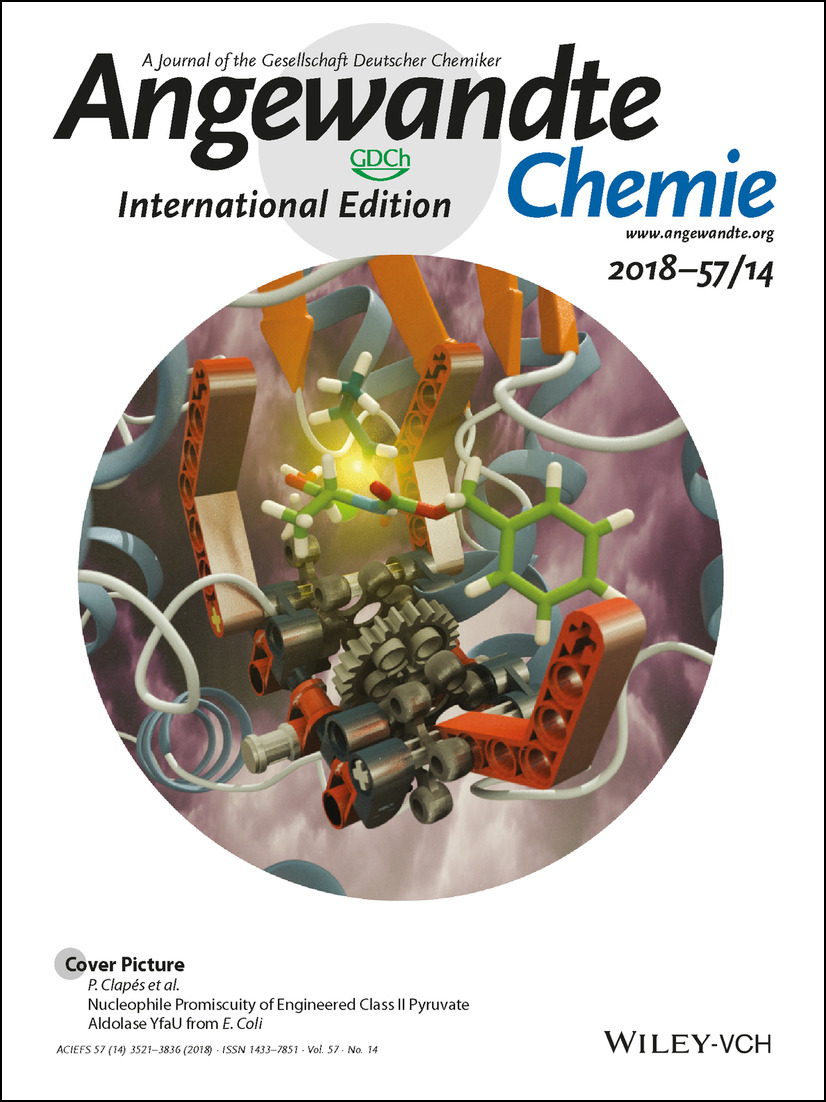
Structure-guided protein engineering of the class II pyruvate aldolase YfaU from E. coli is described. In their Communication on page 3583 ff., P. Clapés and co-workers report the resulting straightforward access to chiral building blocks and proline and pyrrolizidine α-amino acid derivatives. The picture shows how YfaU works like a timing gear to bring together the nucleophile and electrophile to give C−C bond formation. The timing gear has approached the nucleophile at the reactive residue and activation of the nucleophile has occurred (light yellow).
Inside Cover: Directing Aluminum Atoms into Energetically Favorable Tetrahedral Sites in a Zeolite Framework by Using Organic Structure-Directing Agents (Angew. Chem. Int. Ed. 14/2018)
- Page: 3522
- First Published: 27 February 2018
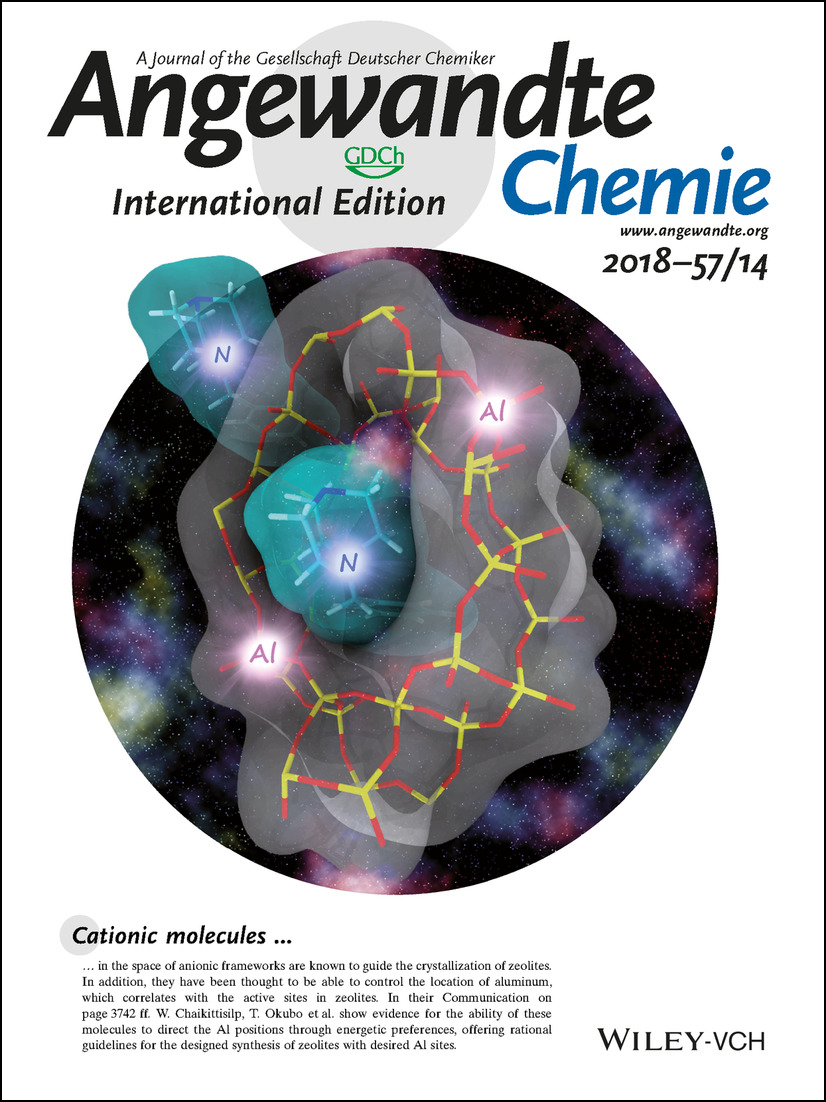
Cationic molecules in the space of anionic frameworks are known to guide the crystallization of zeolites. In addition, they have been thought to be able to control the location of aluminum, which correlates with the active sites in zeolites. In their Communication on page 3742 ff. W. Chaikittisilp, T. Okubo et al. show evidence for the ability of these molecules to direct the Al positions through energetic preferences, offering rational guidelines for the designed synthesis of zeolites with desired Al sites.
Inside Back Cover: Total Synthesis and Conformational Study of Callyaerin A: Anti-Tubercular Cyclic Peptide Bearing a Rare Rigidifying (Z)-2,3- Diaminoacrylamide Moiety (Angew. Chem. Int. Ed. 14/2018)
- Page: 3835
- First Published: 23 February 2018
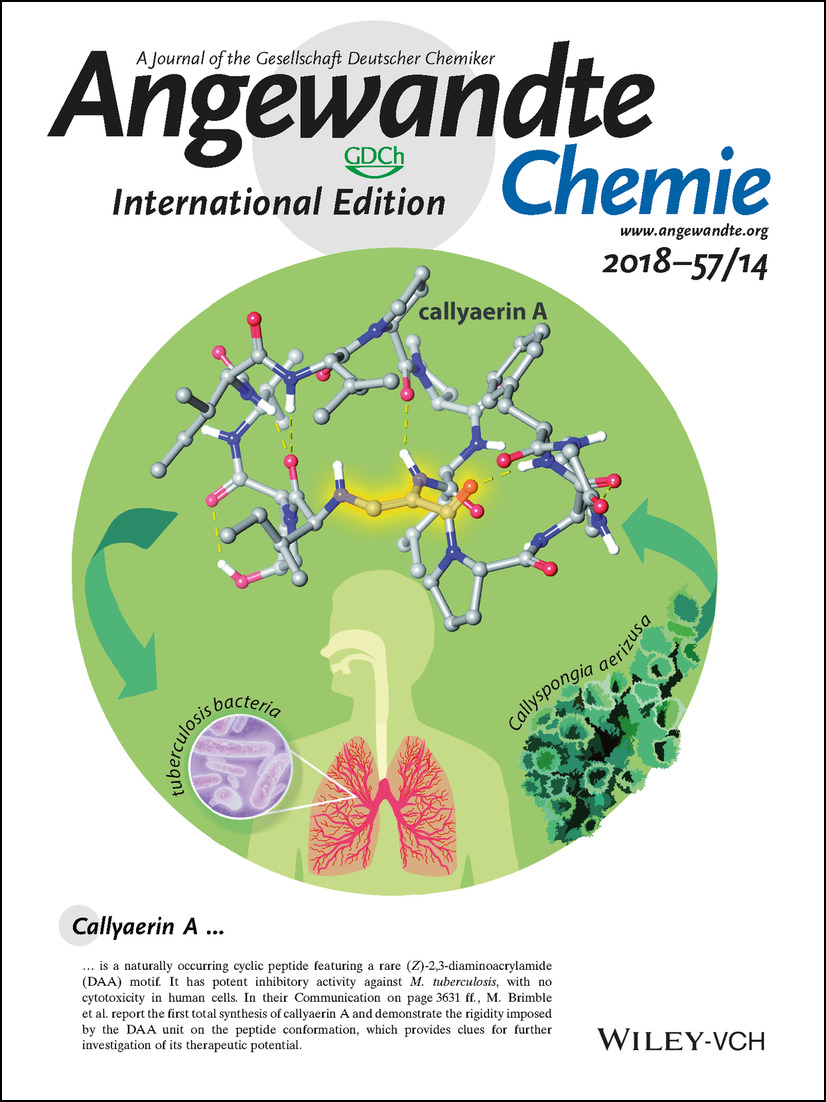
Callyaerin A is a naturally occurring cyclic peptide featuring a rare (Z)-2,3-diaminoacrylamide (DAA) motif. It has potent inhibitory activity against M. tuberculosis, with no cytotoxicity in human cells. In their Communication on page 3631 ff., M. Brimble et al. report the first total synthesis of callyaerin A and demonstrate the rigidity imposed by the DAA unit on the peptide conformation, which provides clues for further investigation of its therapeutic potential.
Back Cover: Broadening the Scope for Fluoride-Free Synthesis of Siliceous Zeolites (Angew. Chem. Int. Ed. 14/2018)
- Page: 3836
- First Published: 09 March 2018
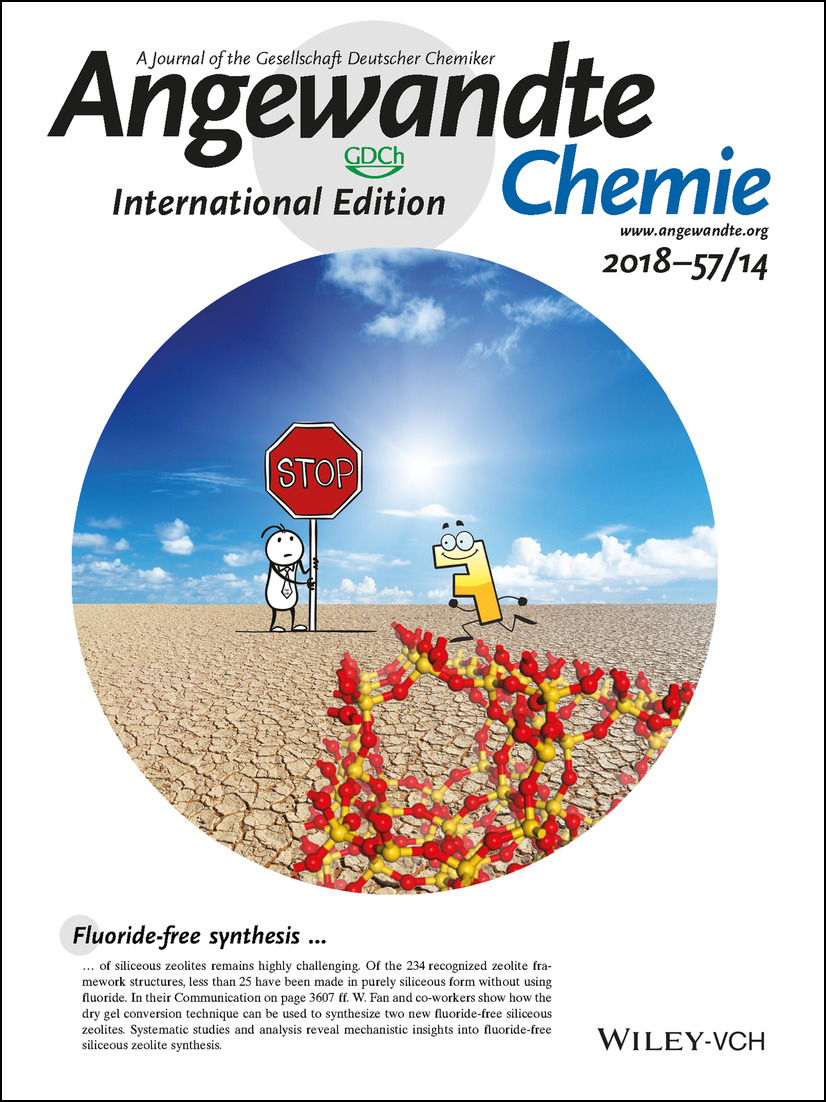
Fluoride-free synthesis of siliceous zeolites remains highly challenging. Of the 234 recognized zeolite framework structures, less than 25 have been made in purely siliceous form without using fluoride. In their Communication on page 3607 ff. W. Fan and co-workers show how the dry gel conversion technique can be used to synthesize two new fluoride-free siliceous zeolites. Systematic studies and analysis reveal mechanistic insights into fluoride-free siliceous zeolite synthesis.
Frontispiece
Frontispiece: Disassembly of Multicompartment Polymer Micelles in Spatial Sequence Using an Electrostatic Field and Its Application for Release in Chronological Order
- First Published: 25 March 2018
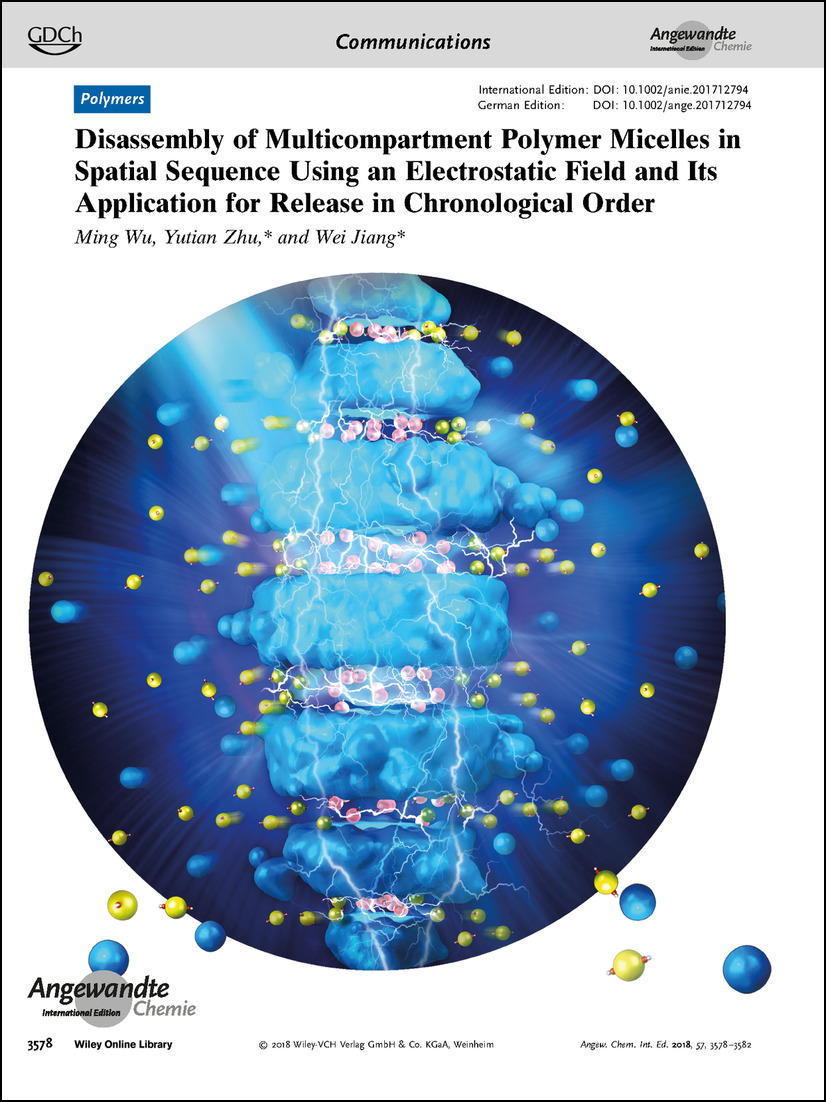
Polymers In their Communication on page 3578 ff., M. Wu, Y. Zhu and W. Jiang report multicompartment micelles that can be disassembled through the release of small spherical micelles using an electrostatic field.
Graphical Abstract
Graphical Abstract: Angew. Chem. Int. Ed. 14/2018
- Pages: 3525-3539
- First Published: 25 March 2018
News
Spotlights on our sister journals: Angew. Chem. Int. Ed. 14/2018
- Pages: 3540-3543
- First Published: 25 March 2018
Author Profile
News
Highlights
CO2 Sequestration
Reviews
Click Chemistry
The [2+2] Cycloaddition-Retroelectrocyclization (CA-RE) Click Reaction: Facile Access to Molecular and Polymeric Push-Pull Chromophores
- Pages: 3552-3577
- First Published: 22 February 2018
![The [2+2] Cycloaddition-Retroelectrocyclization (CA-RE) Click Reaction: Facile Access to Molecular and Polymeric Push-Pull Chromophores](/cms/asset/71618e05-9469-4f05-b7ed-0929ef900720/anie201711605-toc-0001-m.jpg)
Only a click away: Nonplanar donor–acceptor (D-A) chromophores can be prepared by click synthesis through [2+2] cycloaddition-retroelectrocyclization (CA-RE). This is a powerful method for producing functional molecular and polymeric systems for use in next-generation electronic and optoelectronic devices.
Communications
Polymers
Disassembly of Multicompartment Polymer Micelles in Spatial Sequence Using an Electrostatic Field and Its Application for Release in Chronological Order
- Pages: 3578-3582
- First Published: 01 February 2018
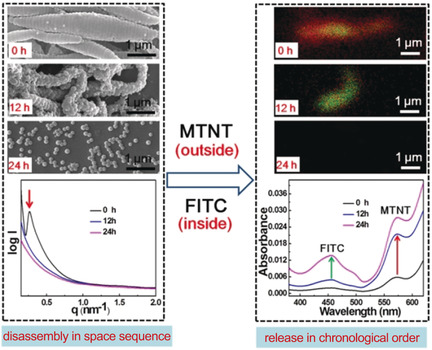
Multicompartment micelles (MCPs), comprising sequences of repeated elemental discoid parts connected by fasciculus, can be disassembled through consequent release of small spherical micelles using an electrostatic field. During this disassembly process, release of loaded species (MTNT and FITC) can be achieved from the MCPs in chronological order.
Biocatalysis
Nucleophile Promiscuity of Engineered Class II Pyruvate Aldolase YfaU from E. Coli
- Pages: 3583-3587
- First Published: 24 January 2018
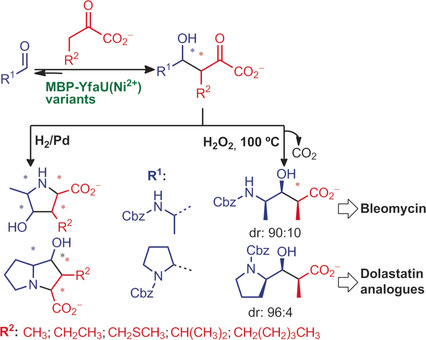
Diverse and easy: Structure-guided rational protein engineering resulted in a 2-keto-3-deoxy-l-rhamnonate aldolase variant fused with a maltose-binding protein (MBP-YfaU W23V/L216A), which can provide straightforward access to chiral building blocks and a series of unprecedented proline and pyrrolizidine α-amino acid derivatives.
Graphene Nanoribbons
Toward Thiophene-Annulated Graphene Nanoribbons
- Pages: 3588-3592
- First Published: 06 February 2018

GN'R light: Narrow thiophene-edged graphene nanoribbons (GNRs) were prepared from polychlorinated thiophene-containing poly(p-phenylene)s using photochemical, metal-free cyclodehydrochlorination (CDHC). The regioselectivity of the CDHC reaction allows the preparation of both longitudinally symmetrical and unsymmetrical GNRs and, consequently, modulation of their optical and electronic properties.
Polymerization
A One-Step Route to CO2-Based Block Copolymers by Simultaneous ROCOP of CO2/Epoxides and RAFT Polymerization of Vinyl Monomers
- Pages: 3593-3597
- First Published: 02 February 2018

The one-step synthesis of CO2-based block copolymers with completely alternating polycarbonate segments was achieved by simultaneous ring opening copolymerization of CO2/epoxides and RAFT polymerization of vinyl monomers. A double chain-transfer effect ensures narrow polydispersities, and a ligand exchange reaction impedes the formation of homopolycarbonates.
Protein Structures
A General Strategy to Access Structural Information at Atomic Resolution in Polyglutamine Homorepeats
- Pages: 3598-3601
- First Published: 23 January 2018

The hunt is on: Huntingtin protein (htt) is the key agent of Huntington's disease, but its high-resolution characterization has been impaired due to the presence of a long tract of consecutive glutamines. By combining nonsense suppression and cell-free expression, single glutamines in htt were site-specifically labeled to perform NMR experiments, thus paving the way to understanding the impact of htt structure and dynamics on Huntington's disease.
Nanopore Sensors
Analyte-Triggered DNA-Probe Release from a Triplex Molecular Beacon for Nanopore Sensing
- Pages: 3602-3606
- First Published: 28 February 2018
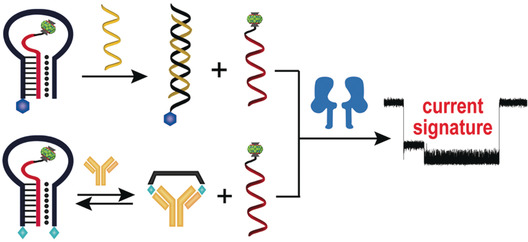
A nanopore sensing strategy based on a triplex molecular beacon was developed for the detection of specific DNA or multivalent proteins. Upon analyte binding, the loop of the molecular beacon is opened and the stem-forming DNA probe is released for nanopore translocation recording. The frequency of current signatures can be used to quantify the concentrations of the analytes.
Zeolite Synthesis
Broadening the Scope for Fluoride-Free Synthesis of Siliceous Zeolites
- Pages: 3607-3611
- First Published: 28 January 2018
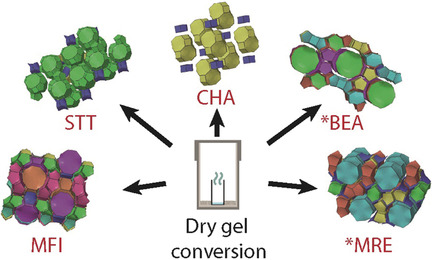
No F required: Fluoride-free synthesis of siliceous zeolites remains highly challenging—of the 234 recognized zeolite framework structures, less than 25 have been made in purely siliceous form without using fluoride. The dry gel conversion technique has been used to synthesize two new fluoride-free siliceous zeolites. Systematic studies and analysis reveal mechanistic insights into fluoride-free siliceous zeolite synthesis.
Electrodes
A Carbon Electrode Functionalized by a Tricopper Cluster Complex: Overcoming Overpotential and Production of Hydrogen Peroxide in the Oxygen Reduction Reaction
- Pages: 3612-3616
- First Published: 02 February 2018
Natural Products
Alkynes From Furans: A General Fragmentation Method Applied to the Synthesis of the Proposed Structure of Aglatomin B
- Pages: 3617-3621
- First Published: 31 January 2018

A general fragmentation method that transforms furans into alkynes, by dual C−C double-bond cleavage, is described. The reaction is proposed to proceed by sequential [4+2] cycloaddition between furan and singlet oxygen, and a formal retro-(3+2) fragmentation of the endoperoxide intermediate. The synthetic utility was demonstrated by a seven-step synthesis of the proposed structure of aglatomin B.
Transition-Metal Catalysis
Nickel-Catalyzed Umpolung Arylation of Ambiphilic α-Bromoalkyl Boronic Esters
- Pages: 3622-3625
- First Published: 15 February 2018

In reverse: A nickel-catalyzed reductive arylation of ambiphilic α-bromoalkyl boronic esters with aryl halides unlocks an opportunity to promote the catalytic cross-electrophile coupling of ambiphilic reagents with aryl halides through a formal reversal of polarity, and is a straightforward alternative for preparing densely functionalized alkyl-substituted organometallic compounds under mild conditions.
Bioimaging
Imaging of Colorectal Cancers Using Activatable Nanoprobes with Second Near-Infrared Window Emission
- Pages: 3626-3630
- First Published: 02 February 2018
Peptides
Total Synthesis and Conformational Study of Callyaerin A: Anti-Tubercular Cyclic Peptide Bearing a Rare Rigidifying (Z)-2,3- Diaminoacrylamide Moiety
- Pages: 3631-3635
- First Published: 18 January 2018
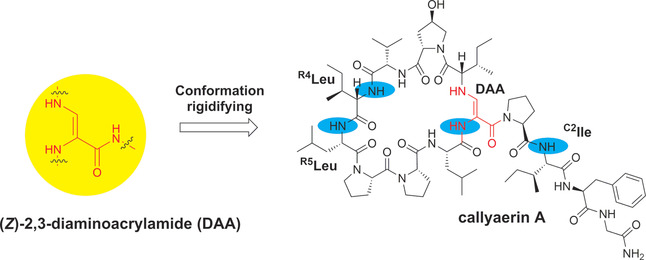
A rigid structure: Callyaerin A, an anti-tuberculosis macrocyclic peptide containing a rare (Z)-2,3-diaminoacrylamide moiety, was synthesized in high yield using an uncommon building block, Fmoc-formylglycine-diethylacetal. Variable-temperature NMR studies revealed the high conformational rigidity that the (Z)-2,3-diaminoacrylamide moiety confers on peptide structure, thus highlighting its potential as a novel structural element for conformation constraints.
Nanostructures
Regulating Higher-Order Organization through the Synergy of Two Self-Sorted Assemblies
- Pages: 3636-3640
- First Published: 07 February 2018
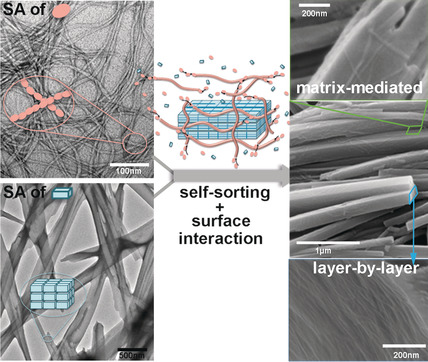
By mimicking the dynamic and reciprocal interactions between the extracellular matrix and cells, the matrix growth-mediated self-assembly (SA) of organic molecules into higher-order organization has been developed. The dynamic self-assembly of a nanofibrous scaffold facilitates the hierarchical assembly of rigid molecule into a layered structure with up to a ninefold increase in height.
Aryl Ether Synthesis
From Anilines to Aryl Ethers: A Facile, Efficient, and Versatile Synthetic Method Employing Mild Conditions
- Pages: 3641-3645
- First Published: 12 February 2018

A simple and direct method for the synthesis of aryl ethers by reacting alcohols/phenols with aryl ammonium salts was developed. This reaction proceeds smoothly and rapidly at room temperature in the presence of a commercially available base, and has a broad substrate scope for both reactants, including natural products, pharmaceuticals, and dyes.
Glycosylation
Direct N-Glycofunctionalization of Amides with Glycosyl Trichloroacetimidate by Thiourea/Halogen Bond Donor Co-Catalysis
- Pages: 3646-3650
- First Published: 07 February 2018

Transformation of amides: Using a halogen bond (XB) donor and Schreiner's thiourea as cooperative catalysts, various amides were directly coupled with glycosyl trichloroacetimidates to give unique N-acylorthoamides in good yields. Synthetic applications of N-acylorthoamides, including rearrangement to the corresponding β-N-glycosides, were also demonstrated.
Polyaromatic Compounds
Radical Alkyne peri-Annulation Reactions for the Synthesis of Functionalized Phenalenes, Benzanthrenes, and Olympicene
- Pages: 3651-3655
- First Published: 05 February 2018
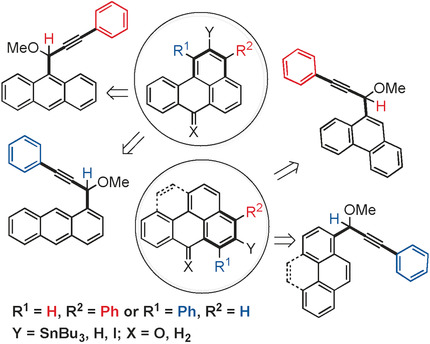
peri useful: Radical cyclization reactions at a peri position were used for the synthesis of polyaromatic compounds. Depending on the choice of reaction conditions and substrate, this flexible approach led to Bu3Sn-substituted phenalene, benzanthrene, and olympicene derivatives (see scheme). Subsequent reactions with electrophiles provided synthetic access to previously inaccessible functionalized polyaromatic compounds.
Lithium-Ion Batteries
Fluoroethylene Carbonate Enabling a Robust LiF-rich Solid Electrolyte Interphase to Enhance the Stability of the MoS2 Anode for Lithium-Ion Storage
- Pages: 3656-3660
- First Published: 26 January 2018
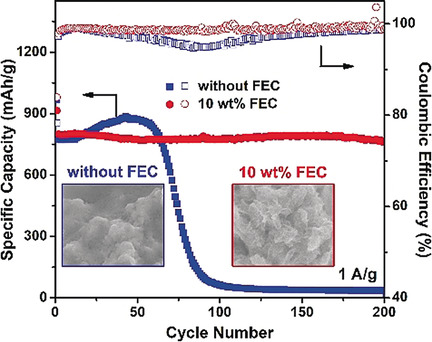
An optimum amount (10 wt %) of fluoroethylene carbonate (FEC) as electrolyte additive enables a robust LiF-rich SEI on MoS2, which significantly suppress the continuous decomposition of electrolytes. As a result, MoS2 in the FEC-containing electrolyte shows an improved lithium storage performance, with a reversible capacity of about 770 mAh g−1 for 200 cycles at 1 A g−1 and a stable capacity of about 510 mAh g−1 at 20 A g−1.
Kinetic Resolution
Scalable, Stereocontrolled Formal Syntheses of (+)-Isoschizandrin and (+)-Steganone: Development and Applications of Palladium(II)-Catalyzed Atroposelective C−H Alkynylation
- Pages: 3661-3665
- First Published: 01 February 2018

Locked into position with a Pd key: A palladium-catalyzed atroposelective C−H alkynylation was developed and applied to gram-scale, stereocontrolled formal syntheses of (+)-isoschizandrin (see scheme) and (+)-steganone. tert-Leucine was identified as an efficient catalytic transient chiral auxiliary for this transformation, which enabled the preparation of a wide range of enantiomerically enriched biaryl compounds in good yields.
Chirality
Predicting the Helical Sense of Poly(phenylacetylene)s from their Electron Circular Dichroism Spectra
- Pages: 3666-3670
- First Published: 06 February 2018
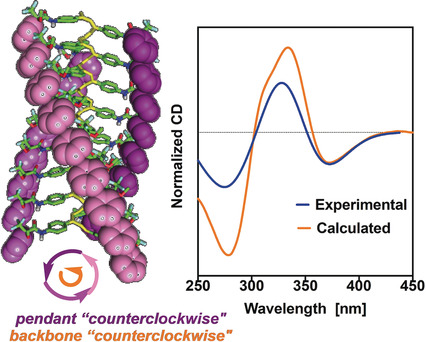
Helical polymers: A computational methodology on poly(phenylacetylene) oligomers allows assignment of the helical sense of polyene backbones based on their electron circular dichroism (EDC) signature. The calculated ECD spectrum for small oligomers of polyphenylacetylenes (PPAs) shows a very good match with the experimental spectra of the PPA polymers.
Natural Products
Crystalline-Sponge-Based Structural Analysis of Crude Natural Product Extracts
- Pages: 3671-3675
- First Published: 07 February 2018

Crystal clear: A crystalline sponge (CS)-based method was developed for the prioritization of target analytes present in a methanolic crude extract from a red alga. Subsequent analysis by the CS method enabled the clarification of the structures of six sesquiterpenoid natural products, starting from only around 10 mg of the crude extract.
Metal–Organic Frameworks
Probing Substrate Diffusion in Interstitial MOF Chemistry with Kinetic Isotope Effects
- Pages: 3676-3681
- First Published: 09 February 2018
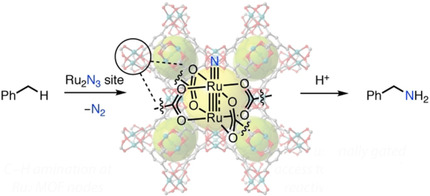
Nitrogen atom transfer from a lattice-confined Ru2 nitride to toluene generates benzylamine. The intramolecular deuterium kinetic isotope effect (KIE), determined for the amination of a partially deuterated substrate, was compared with the intermolecular KIE, determined by competitive amination of a mixture of perdeuterated and nondeuterated substrate, to establish the relative rates of substrate diffusion and interstitial chemistry.
Asymmetric Catalysis
Rhodium-Catalyzed Arylation of Cyclopropenes Based on Asymmetric Direct Functionalization of Three-Membered Carbocycles
- Pages: 3682-3686
- First Published: 15 February 2018
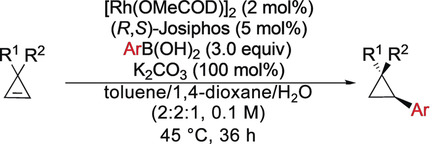
Small ′Rh′ings: The asymmetric rhodium-catalyzed arylation of simple achiral nonfunctionalized cyclopropenes provides a variety of arylated cyclopropanes with high diastereo- and enantioselectivities (e.r. from 90:10 to 99:1). The reaction proceeds under mild reaction conditions. cod=1,5-cyclooctadiene.
Phase Transfer
Reversible Phase Transfer of Carbon Dots between an Organic Phase and Aqueous Solution Triggered by CO2
- Pages: 3687-3691
- First Published: 11 February 2018

Amine-terminated CDs reversibly transfer between aqueous and organic solvents switched by CO2 at atmospheric pressure. This property was used to demonstrate effective homogeneous catalysis and heterogeneous separation. Catalyst recycling was developed and their phase transfer behavior was investigated by fluorescence and 13C NMR spectroscopy.
Asymmetric Synthesis
Biocatalytic Conversion of Cyclic Ketones Bearing α-Quaternary Stereocenters into Lactones in an Enantioselective Radical Approach to Medium-Sized Carbocycles
- Pages: 3692-3696
- First Published: 02 February 2018

Best of both worlds: Cyclic ketones with α-quaternary centers underwent kinetic resolution with a cyclohexanone monooxygenase (CHMO) to give lactones with tetrasubstituted stereocenters with high enantioselectivity (see scheme). Subsequent SmI2-mediated cyclization led to complex cycloheptan- and cycloctan-1,4-diols. Enantiomerically enriched cyclic ketones from the resolution were converted into cyclobutanols by SmI2-mediated cyclization.
Reversible H2 Activation
Reversible Dihydrogen Activation and Hydride Transfer by a Uranium Nitride Complex
- Pages: 3697-3700
- First Published: 25 January 2018
Shape Memory Polymers
A Smart Superwetting Surface with Responsivity in Both Surface Chemistry and Microstructure
- Pages: 3701-3705
- First Published: 11 February 2018
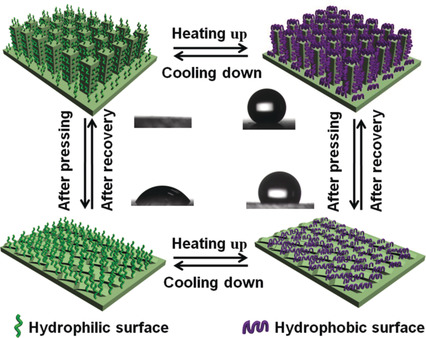
A surface with controllability in both the surface chemistry and microstructure is constructed by grafting the poly(N-isopropylacrylamide) (PNIPAAm) onto shape memory polymer (SMP) pillars. Based on the excellent controllability, reversible and precise wetting control from superhydrophilicity to superhydrophobicity can be realized, which also allows the surface to be used as a rewritable platform for designing various gradient wettings.
Host–Guest Systems
Hydrophilic Oligo(lactic acid)s Captured by a Hydrophobic Polyaromatic Cavity in Water
- Pages: 3706-3710
- First Published: 01 February 2018

Incompatible interactions: The hydrophobic cavity of a polyaromatic capsule efficiently encapsulated hydrophilic oligo(lactic acid)s in water (see scheme). The X-ray crystallographic and ITC analyses revealed that the unusual host–guest behavior is caused by enthalpic stabilization through multiple CH–π and hydrogen bonding interactions.
Analytical Methods
Combinatorial Probes for High-Throughput Electrochemical Analysis of Circulating Nucleic Acids in Clinical Samples
- Pages: 3711-3716
- First Published: 01 February 2018
Supramolecular Chemistry
Selective Anion Extraction and Recovery Using a FeII4L4 Cage
- Pages: 3717-3721
- First Published: 02 February 2018
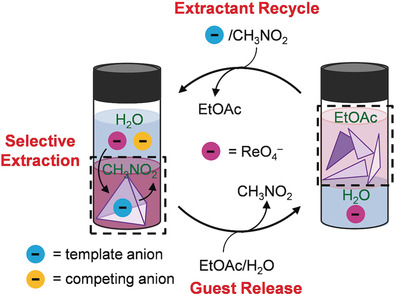
A FeII4L4 coordination cage enabled complete extraction of ReO4−, a nonradioactive surrogate of TcO4−, from water into an organic phase. In the presence of 10 other anions, 97 % of ReO4− was selectively removed. The extracted ReO4− could be released and the cage extractant recycled by a solvent-switching strategy. Rendering the cage water-soluble also allowed complete extraction of ReO4− from an organic phase into water.
Photochemistry
Coumarin Photocaging Groups Modified with an Electron-Rich Styryl Moiety at the 3-Position: Long-Wavelength Excitation, Rapid Photolysis, and Photobleaching
- Pages: 3722-3726
- First Published: 15 February 2018
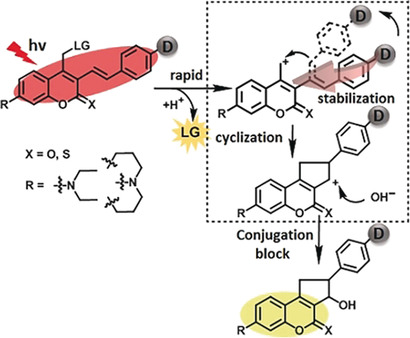
Rattling the cage: A new class of coumarin-based photocaging groups, with an electron-rich styryl moiety at the 3-position, were synthesized. They feature large π-conjugation, carbocation stabilization, and undergo an intramolecular cyclization rearrangement. Their long-wavelength excitation, rapid photolysis, and photobleaching are beneficial for use in high-concentration and thick specimens. D=electron donor, LG=leaving group.
Zeolites | Very Important Paper
Two Aluminophosphate Molecular Sieves Built from Pairs of Enantiomeric Structural Building Units
- Pages: 3727-3732
- First Published: 05 March 2018
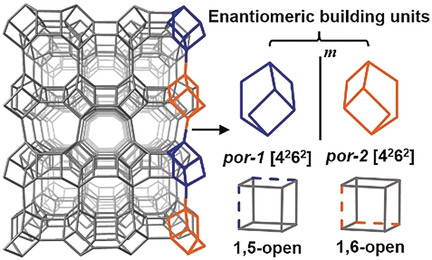
Pores of hands: Two structurally related small-pore AlPO4 molecular sieves, PST-13 and PST-14, were synthesized. Their structures were solved and refined by electron crystallography, which showed that PST-13 and PST-14 consist of pairs of enantiomeric structural building units, namely, tetrahedral ([4262]) 1,5-open and 1,6-open double 4-rings.
Porphyrins
A Benzene-1,3,5-Triaminyl Radical Fused with ZnII-Porphyrins: Remarkable Stability and a High-Spin Quartet Ground State
- Pages: 3733-3736
- First Published: 14 February 2018
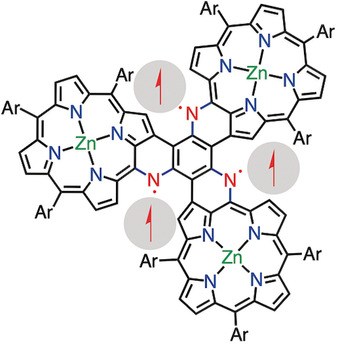
In a spin: A benzene-1,3,5-triaminyl radical fused with three ZnII-porphyrins was synthesized, and was shown to possess a quartet ground state by ESR and superconducting quantum interference device (SQUID) studies. Despite its high-spin nature, this triradical is remarkably stable under ambient conditions. The high stability of the triradical is attributed mainly to effective spin delocalization over the porphyrin segments.
Metal–Organic Frameworks | Hot Paper
A Cooperative Pillar–Template Strategy as a Generalized Synthetic Method for Flexible Homochiral Porous Frameworks
- Pages: 3737-3741
- First Published: 01 March 2018

Pushing pillars apart: A new strategy for creating homochiral MOFs was developed through the fusion of pillaring and templating concepts. This dual-concept strategy makes use of the synergy among multiple competing interactions in a tri-organic system, leading to the synthesis of a series of flexible homochiral frameworks.
Zeolites
Directing Aluminum Atoms into Energetically Favorable Tetrahedral Sites in a Zeolite Framework by Using Organic Structure-Directing Agents
- Pages: 3742-3746
- First Published: 05 February 2018
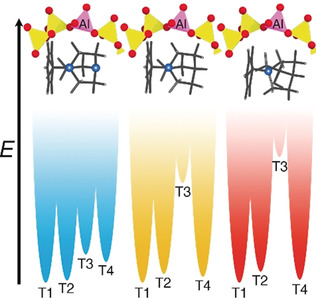
Put in their places: IFR-type zeolites with tuned Al locations at different tetrahedral sites (T1–T4) are synthesized with different organic structure-directing agents (OSDAs), revealing the Al site-directing ability of OSDAs. The occupancy of Al at each site is strongly correlated with the energies of the zeolite–OSDA complexes, suggesting that the Al locations are primarily governed by the energetic preferences.
Lignin-Model Chemistry
Palladium-Catalyzed Reductive Insertion of Alcohols into Aryl Ether Bonds
- Pages: 3747-3751
- First Published: 08 February 2018

High-functioning alcoholic: A method is described for valorization of lignin model compounds. Reductive alcoholysis of aryl ethers catalyzed by palladium in alcoholic solvent is initiated by partial hydrogenation of the arene ring to an enol ether. Cleavage of the strong aryl C−O bond is achieved by alcohol addition to the enol ether and R−OH elimination.
Palladium-Catalyzed Formal Cross-Coupling of Diaryl Ethers with Amines: Slicing the 4-O-5 Linkage in Lignin Models
- Pages: 3752-3757
- First Published: 31 January 2018
Photoelectrochemistry
Single-Nanoparticle Photoelectrochemistry at a Nanoparticulate TiO2-Filmed Ultramicroelectrode
- Pages: 3758-3762
- First Published: 09 February 2018

Single-nanoparticle photoelectrochemistry: A phototelectrochemical method is used for quantifying the electron transfer of a single N719@TiO2 nanoparticle and evaluating the nanostructured TiO2 film by experiment and simulation. These results provide new insights to facilitate the fabrication of photoelectrochemical devices with better performance.
Organocatalysis
Counterion-Induced Asymmetric Control in Ring-Opening of Azetidiniums: Facile Access to Chiral Amines
- Pages: 3763-3766
- First Published: 12 February 2018

Going through a phase: Counterion-induced asymmetric control of reactions of tetrahedral ammonium cations is useful but remains challenging. Demonstrated here is the use of chiral anion phase-transfer catalysis to achieve ring-opening reactions of readily available tetrahedral azetidiniums with good enantioselectivities. Precise control over the formation and reaction of the key chiral ion pair, as well as inhibition of the background reaction by the biphasic system, is key to the success of this method.
Catalytic Enantioselective Aza-Benzoin Reactions of Aldehydes with 2H-Azirines
- Pages: 3767-3771
- First Published: 13 February 2018

′Az′ is: The enantioselective aza-benzoin reaction of aldehydes with 2H-azirines was developed by utilizing a chiral N-heterocyclic carbene (NHC) as the catalyst. A wide range of corresponding aziridines can be obtained in good yields with high enantioselectivities. The obtained optically active aziridines should be useful in the synthesis of other valuable molecules. MTBE=methyl tert-butyl ether.
Nanostructures
Local-Curvature-Controlled Non-Epitaxial Growth of Hierarchical Nanostructures
- Pages: 3772-3776
- First Published: 07 February 2018
Biaryls
Dynamic Kinetic Resolution of Heterobiaryl Ketones by Zinc-Catalyzed Asymmetric Hydrosilylation
- Pages: 3777-3781
- First Published: 13 February 2018

The dynamic duo: A nitrogen atom and the carbonyl group in heterobiaryl ketones form a Lewis pair which is responsible for the labilization of the stereogenic axis, and constitutes the key strategy for developing a zinc-catalyzed asymmetric hydrosilylation by dynamic kinetic resolution. This process simultaneously installs a stereogenic axis and a stereocenter for the highly enantioselective synthesis of heterobiaryl carbinols.
Organocatalysis
Lewis Base-Promoted Ring-Opening 1,3-Dioxygenation of Unactivated Cyclopropanes Using a Hypervalent Iodine Reagent
- Pages: 3782-3786
- First Published: 12 February 2018

Lewis base activation of iodine: A facile and effective system has been developed for the regio- and chemoselective ring-opening/electrophilic functionalization of cyclopropanes through C−C bond activation by [bis(trifluoroacetoxy)iodo]benzene with the aid of the Lewis base promoter p-toluenesulfonamide.
Perovskite Solar Cells
High-Purity Inorganic Perovskite Films for Solar Cells with 9.72 % Efficiency
- Pages: 3787-3791
- First Published: 30 January 2018

All-inorganic perovskite films were fabricated by a multistep solution-processed deposition strategy, in which a phase conversion from CsPb2Br5 to CsPbBr3 and then to Cs4PbBr6 was achieved upon increasing deposition cycles of a cesium bromide solution. A power conversion efficiency up to 9.72 % was obtained from the CsPbBr3 solar cells, which are free of hole-transporting layers.
Radical Reactions
Direct Cyclization of Tertiary Aryl Amines with Iodonium Ylides
- Pages: 3792-3796
- First Published: 12 February 2018

In an impressive show of independence, iodonium ylides underwent direct cyclization with unmodified tertiary aryl amines (see scheme). The transformation, which was developed on the basis of the exceptional finding that iodonium ylides could cleave the C(sp3)−H bonds of tertiary aryl amines, proceeded in the absence of a transition-metal catalyst and without the use of an additional initiator/oxidant.
Porphyrinoids
Direct and Regioselective Amination of β-Unsubstituted 5,15-Diazaporphyrins with Amines: A Convenient Route to Near-Infrared-Responsive Diazaporphyrin Sensitizers
- Pages: 3797-3800
- First Published: 02 February 2018

At a single stroke: A convenient method has been developed for the base-promoted direct amination of β-unsubstituted 5,15-diazaporphyrins (DAP) with secondary and primary amines to produce 3,7,13,17-tetraamino- and 3-amino-DAPs, respectively (see scheme; Ar=2,4,6-Me3C6H2). The palladium complex of the 3,7,13,17-tetrakis(diphenylamino)-DAP generated singlet oxygen in high yield under irradiation with near-infrared light.
Total Synthesis
Total Synthesis and Stereochemical Revision of Iriomoteolide-2a
- Pages: 3801-3805
- First Published: 31 January 2018
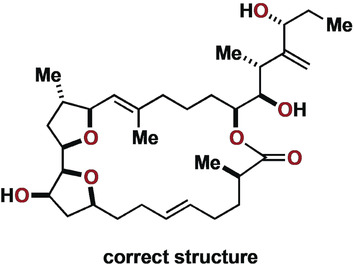
Absolutely correct: Iriomoteolide-2a, a cytotoxic 23-membered macrolide natural product of marine origin, was obtained by total synthesis for the first time. The study culminated in a revision of the original stereochemical assignment and the unambiguous determination of the correct absolute configuration.
Indole alkaloids
Highly Enantioselective Tandem Michael Addition of Tryptamine-Derived Oxindoles to Alkynones: Concise Synthesis of Strychnos Alkaloids
- Pages: 3806-3809
- First Published: 08 February 2018

Give me a ring: A novel method for synthesizing strychnos alkaloids was developed in which a chiral N,N′-dioxide Sc(OTf)3 complex catalyzes the enantioselective tandem Michael addition of tryptamine-derived oxindoles to alkynones. The reaction enables the facile preparation of enantioenriched spiro[pyrrolidine-3,3′-oxindole] compounds, which provides a novel strategy for the synthesis of monoterpenoid indole alkaloids.
Asymmetric Catalysis
Highly Enantioselective [3+2] Annulation of Indoles with Quinones to Access Structurally Diverse Benzofuroindolines
- Pages: 3810-3814
- First Published: 05 February 2018
![Highly Enantioselective [3+2] Annulation of Indoles with Quinones to Access Structurally Diverse Benzofuroindolines](/cms/asset/e237977b-41a9-4218-96f8-7a32b3321cd6/anie201800733-toc-0001-m.jpg)
Thinking outside the BOX: A CuII-catalyzed asymmetric [3+2] annulation of indoles with quinones provides diverse access to the optically pure benzofuroindolines, including those without 3-substituents that are susceptible to rearomatization, for the first time. The use of a BOX ligand copper hydrate complex in combination with activated molecular sieves for the controlled release of H2O leads to reproducibly high yields and excellent enantioselectivity.
C−H Activation
Direct Palladium-Catalyzed β-Arylation of Lactams
- Pages: 3815-3819
- First Published: 08 February 2018

Merger negotiations: Direct β-arylation of N-protected lactams with simple aryl iodides was developed by merging soft enolization and palladium-catalyzed redox cascade. The reaction is operated under mild reaction conditions, is scalable, and is chemoselective. DIPEA=diisopropylethylamine, PG=protecting group, TFA=trifluoroacetate, Tf=trifluoromethanesulfonyl.
Atmospheric Chemistry | Very Important Paper
Accretion Product Formation from Self- and Cross-Reactions of RO2 Radicals in the Atmosphere
- Pages: 3820-3824
- First Published: 01 February 2018
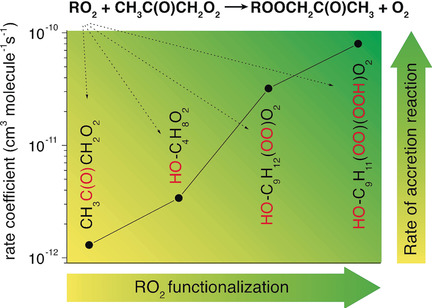
Rapidly paired up: RO2 radicals in the atmosphere form accretion products according to RO2+R′O2→ROOR′+O2. This pathway is very efficient for functionalized RO2 radicals, reaching rates that surpass those of the competitive NO+RO2 and HO2+RO2 reactions. Accretion product formation is currently not yet considered in the description of atmospheric oxidation processes.
CH Activation
Double CH Activation of a Masked Cationic Bismuth Amide
- Pages: 3825-3829
- First Published: 01 February 2018

Cationization is presented as a new strategy for bismuth(III)-mediated CH activation. A (masked) cationic bismuth compound was used for the highly selective, stepwise double CH activation of diphenyl amide, (NPh2)−. Simple procedures for the straightforward functionalization of the activated positions are presented, and mechanistic aspects of these transformations are elucidated.
Organocatalysis
Iodine(III) Derivatives as Halogen Bonding Organocatalysts
- Pages: 3830-3833
- First Published: 24 January 2018
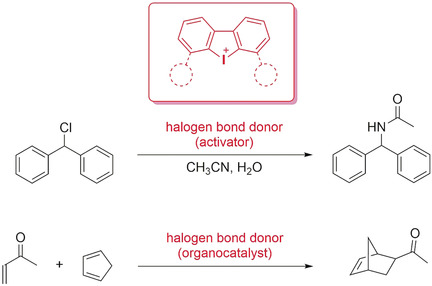
Activation with iodine: Hypervalent iodine(III) compounds were used as activators or organocatalysts in benchmark reactions. The crucial role of halogen bonding in these processes was demonstrated for the first time by a series of comparative experiments, including with sterically blocked derivatives. The activities of these monodentate Lewis acids match or exceed those of previously used bidentate cationic halogen bond donors.




